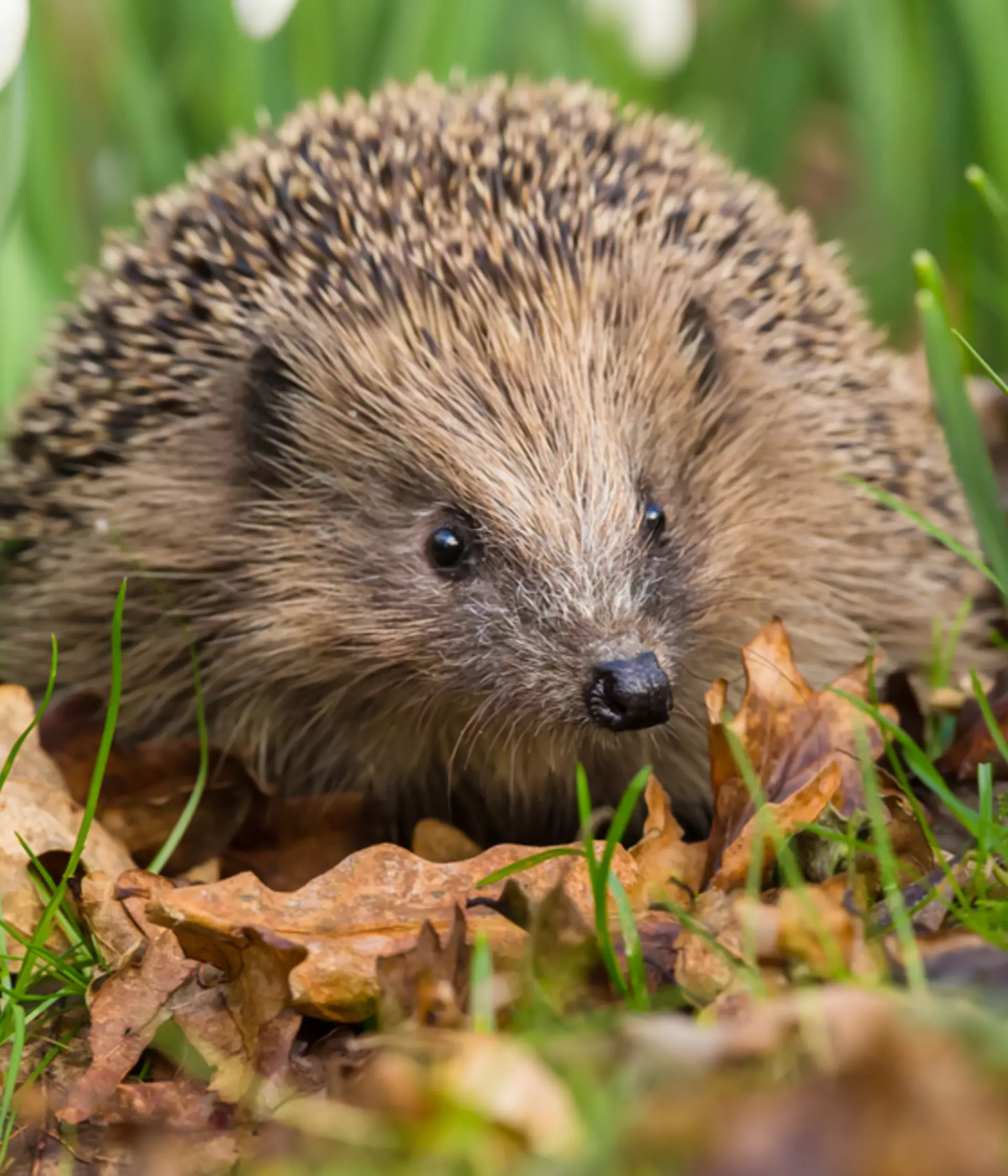
Email: hogwatch@zsl.org
Prof. Chris Carbone
Professor, IOZ
Dr. Robin Freeman
Head of Indicators and Assessments Unit
Prof. Marcus Rowcliffe
Professor
London HogWatch identifies hedgehog populations in Greater London to promote conservation strategies for their protection, connection, and expansion
What do we do?
London HogWatch was established in 2016 to identify the locations of the main hedgehog populations in Greater London. By increasing our understanding of hedgehog abundance and distributions, we can better inform future conservation management strategies and help halt the decline of hedgehog populations in London.
So far, HogWatch has conducted major surveys of some of the most important green spaces supporting hedgehog populations, in addition to exploring new locations where there was deficient information on hedgehog presence and absence. More specifically, we have identified substantial hedgehog ‘hotspots’ - in northeast London including in the Highgate and Hampstead area, and others in the southwest Barnes and Twickenham area, in addition to several smaller populations across West, North and South London.
Why hedgehogs?
Hedgehogs have recently been classified as ‘near threatened’ as their numbers are estimated to have declined between 30-75% in the UK since 2000. Multiple factors may be interacting to produce this effect, including habitat loss and fragmentation, use of pesticides and agricultural chemicals, and road traffic.
Historically, hedgehogs have been an integral element of both urban and rural biodiversity in the UK but have declined dramatically in recent years. Evidence suggests that this decline has been particularly severe in rural areas, highlighting the significance of urban hedgehog populations for conserving this species. Hedgehogs occur in several areas across Greater London, but our current understanding of these remaining populations is poor. For us to take effective conservation measures, a greater knowledge of their distribution and population sizes in London is required.
How do we do it?
Between April and October, we carry out systematic camera trapping surveys across Greater London in a range of different habitats, including parks, gardens, and private green spaces. This allows us to collect data on the presence and absence of hedgehog populations. Camera trapping also means we can monitor the occurrence of other London wildlife populations that might impact hedgehogs. Our analyses of the data enable us to address knowledge gaps about the occurrence, size, and connectivity of hedgehog populations. With this information, we can detect where habitats have become fragmented, for example we have identified roads as a major threat for London’s hedgehogs, which prevent them from accessing otherwise suitable habitats.
London HogWatch’s ability to conduct surveys is only achievable with the kind support of our funders and collaborators. We work with a variety of groups including councils, local environmental groups, charities, and companies. We are particularly grateful for the support of the British Hedgehog Preservation Society, HogWatch's core funder, without whom this work would not be possible.
HogWatch continues to expand every year and has currently carried out surveys in two thirds of all London Boroughs and put out nearly 4000 camera traps across London. The map below shows London boroughs HogWatch has surveyed in since the project began in 2016, each year the scope of our work continues to expand into new areas.
Public engagement
Our work across various London Boroughs would not be possible without the help of numerous volunteers from community groups, residents, and societies. HogWatch is constantly undertaking camera trap surveys that involve large numbers of volunteers, providing the opportunity for members of the community to get out into nature and help wildlife local to them. Volunteers help us set up cameras in London’s parks and green spaces and take cameras home to conduct their own garden survey. These garden surveys are an important addition to our data as gardens can act as important refuges for hedgehogs in highly urbanised areas.
Citizen Science: Our work combines citizen science data obtained from various external charities such as, NBN, GiGL and PTES. We have used this information to better understand hedgehog habitat use across the capital which can be found here. We have also recently conducted our own historical knowledge survey to understand the recent present and past distributions of hedgehogs. If you would like to fill out our short questionnaire, the website can be found here.
School’s education: The iconic status of hedgehogs, along with the conservation technology that underpins this work, provides an ideal platform for supporting schools’ education activities. Throughout the programme, we have made several schools visits (both in primary and secondary schools), supported work experience placements for secondary school and university pupils and delivered talks to school visitors at ZSL.
National Hedgehog Monitoring Programme
A pioneering new three-year pilot project - the National Hedgehog Monitoring Programme (NHMP) – was launched in Spring 2024. Led by wildlife charities The British Hedgehog Preservation Society (BHPS) and People’s Trust for Endangered Species (PTES), in partnership with Nottingham Trent University, ZSL’s London HogWatch, Durham University and MammalWeb, and largely funded by Natural England, this unique combination of AI, trail cameras and home-based volunteers will produce crucial insights into the factors causing hedgehog populations to plummet, and enable conservationists to implement practical conservation measures to try to reverse the decline.
For the first time, this will enable robust estimates of hedgehog populations in different habitats across the country, show how these are changing year on year, and, in time, give a national estimate of Britain’s hedgehog population. The new project utilises sophisticated, cutting-edge artificial intelligence (AI), which is a world-first in hedgehog conservation. ZSL’s cutting-edge camera-trapping techniques which have advanced population estimation, have been the basis of the NHMP methodology. To sign up and become a ‘spotter’, visit ptes.org/nhmp.

Hampstead Heath
Through our camera trap surveys we’ve established Hampstead Heath is a stronghold area for London’s hedgehog population, with some of the highest hedgehog sightings found across London. In 2018, HogWatch partnered with City of London Corporation and Heath hands to undertake a large-scale 150 camera trap survey of Hampstead Heath over a two-week period. Hedgehogs were well distributed across the park with an overall 376 hedgehog sightings across 51% of cameras. To ensure long-term monitoring of this key hedgehog stronghold, a second 150 camera-trap survey was completed in 2021, and a third 150-camera trap survey took place in the spring of 2024. So far, findings indicate that this area has a robust hedgehog population which needs long-term, continuous monitoring to ensure conservation of this key population.

Regents Park
Annual torchlight surveys of hedgehog populations in Regents Park have been conducted by The Regent’s Park Hedgehog Research Project since 2014. London HogWatch has been completing large-scale camera trap surveys in Regents Park since 2016, to help contribute knowledge on this population. Both torchlight and camera surveys have shown fluctuations in the hedgehog population but overall, a decline in the last decade. This is now thought to be the last breeding population in central London, which has become small and isolated, making Regents Park a vital area for hedgehog conservation within London.
Findings from Dr Jessia Turner (who completed her PhD on the genetics of London’s hedgehogs with HogWatch) identified that the Regent’s Park population is highly inbreed compared to neighbouring central London and greater London populations. She has now been hired to write genetic and telemetric monitoring protocols. Alongside Dr Turner, Hogwatch is actively involved in the Regents Park Hedgehog Research Project examining how to improve the conservation status of this isolated population in central London.
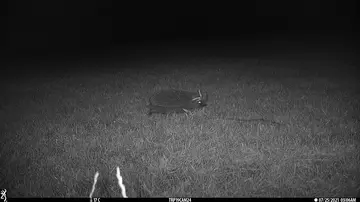
Rewild London project (North London)
As part of the Mayor of London’s Rewild Fund (Rewild London Fund | London Wildlife Trust) in 2022, London HogWatch worked with a range of community partners from 13 SINCs in the North Camden area, to assess distributions of hedgehogs and other important wildlife species to help target areas that act as critical corridors of movement between SINCs. The project aimed to fill the knowledge gap on the extent of hedgehog distributions between Hampstead Heath and Regent’s Park by combining information from camera-trap surveys in seven SINCs, and a historical knowledge survey Hedgehog and wildlife survey.
The data collected from this project helped identify five potential wildlife corridors which could extend and strengthen hedgehog populations by linking Hampstead Heath with other surrounding SINCs. These were; Hampstead Heath to Waterlow Park SINC, Hampstead Heath to Kentish Town City Farm SINC, Hampstead Heath to Branch Hill SINC, Hampstead Heath to Barnet SINCs through Hampstead Garden Suburb, and Hampstead Heath to Haringey SINCs through Highgate. Local environmental groups and SINC managers are now working on ways to implement improving connectivity between these SINCs. The historical knowledge survey has also now been extended to London wide and is still being utilised to collate important citizen science data.
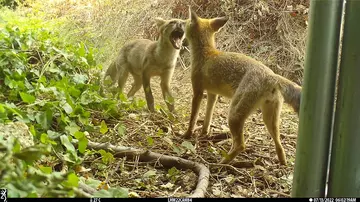
Barnes
HogWatch has been working in collaboration with Friends of Barnes Common, Barnes Hedgehogs, and Richmond Council to survey in the Barnes area since 2018. We identified this area as a potential hedgehog hotspot after our initial survey of Barnes Common and Putney Lower revealed high hedgehog activity. Since then, many other areas in Barnes have been surveyed and revealed a large hedgehog distribution in the area. Unfortunately, our analysis has shown a decline in abundance and distribution over the six-year monitoring period, especially on Barnes Common. Reasons for this decline are unknown but we continue to monitor the area and support local conservation strategies. Our results suggest that gardens are acting as important refuges for hedgehogs here and Barnes Hedgehogs continues the important work of putting holes in fences to create hedgehog highways to help conserve this population. In 2023 Barnes Common became one of our NHMP monitoring sites and will continue to be monitored through this programme in the coming years, the last survey was in August 2024.
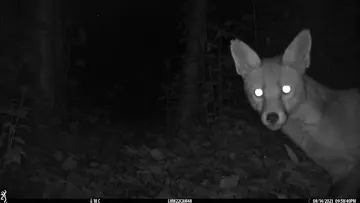
Chiswick
HogWatch started surveying Chiswick in 2021 in collaboration with WildChiswick. This revealed a strong hedgehog population in Chiswick House and Gardens which extended across the Grove Park and Strand on the Green area of Chiswick. Promoting the results from the surveys in the local area meant people became more aware of hedgehogs and their needs. WildChiswick was able to start a hedgehog highway campaign by putting holes in garden fences and directing these efforts to where it was most beneficial to the hedgehog population. Once residents knew hedgehogs were in the area, WildChiswick has been able to do successful outreach activities such as talking to people about how to make their gardens more hedgehog friendly and speaking in school assemblies. This work is vital as when people know there are hedgehogs in their area, there is an incentive to take action. In 2024, Chiswick was one of our new NHMP monitoring sites and will continue to be monitored through this programme in the coming years.
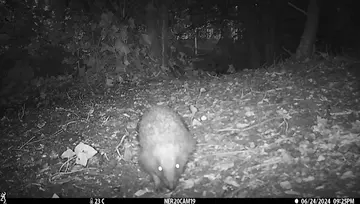
Kingston
HogWatch has been working with Kingston Council to investigate the hedgehog population within the borough. In 2021, a survey in the Surbiton area was conducted which found only a few sightings, suggesting the population here is small and in need of conservation action. The results also helped identify an adjacent area, which included residential sites, for further study in 2022. This survey revealed how important garden habitat is for hedgehogs, as high amounts of activity were detected here. Amazingly, the 2022 Kingston survey also detected a pine marten, the first record in London for over a century. Highlighting the importance of biodiversity monitoring and how useful camera traps can be for picking up rare or elusive species.
In 2023, HogWatch and Kingston Council were funded by Internet of Things to monitor hedgehog and other species in real-time using cellular cameras. Surveys showed higher hedgehog activity in parks than in previous years and revealed a strong diversity of mammal and bird species. In 2024, we conducted a survey in North Kingston in an area that had not been surveyed before, enhancing our knowledge of the extent of hedgehog presence across the borough. We also conducted a second survey in 2024 as Kingston became one of our NHMP monitoring sites, meaning it’ll continue to be surveyed through this programme in the coming years.
Our collaborative work with Kingston Council was recently featured on BBC Breakfast. Our survey findings in Old Malden suggested the area is a possible hedgehog hotspot, as a result, Kingston Council implemented four “Hedgehogs crossing” road signs in Old Malden to help alert drivers to be aware of their presence. These signs, which are approved by the Department of Transport, are the first official signs to be implemented by a Council in England. Kingston Council has launched a biodiversity partnership which brings together conservation practitioners and groups in the Borough. We are leading the Hedgehog Action Group and are helping to write the Hedgehog Species Action Plan. We are using the data from HogWatch surveys in the Borough from the last three years to identify areas to target for hedgehog conservation and connectivity.

Ealing
In 2022, we partnered with Ealing Wildlife Group to support their Hedgehog Highways project. 60 cameras were deployed in a range of park, garden and allotment habitats. Positively, hedgehogs were detected in four of the seven surveyed sites. In 2024, we continued our collaboration, deploying 42 cameras across five new park habitats. Preliminary findings are encouraging, with hedgehogs detected at three of these sites. Ealing Wildlife Group are utilising HogWatch survey results to locate areas for hedgehog highways, create hibernacula and engage with the community through educational events.
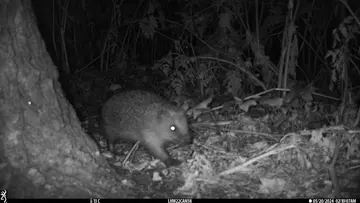
Richmond Park
In spring of 2024, alongside Friends of Richmond Park and Royal Parks, 150 cameras were deployed in Richmond Park to monitor and provide insight into the park's biodiversity.
This work carries on from previous surveys in the borough of Richmond including a survey of Bushy Park and other key green spaces as part of a project funded by Internet of Things through the South London Partnership. In 2022 London HogWatch worked with Richmond Council using cellular cameras to gather fauna data to inform its nature recovery strategy. This data was combined with other information to advise an approach that considers site connectivity, climate change resilience and the priority actions for habitats and species. Data gathered will also be used in the future to monitor the success of planned conservation actions. HogWatch has surveyed Crane Park Island for water voles prior to the planned reinforcement of the population.
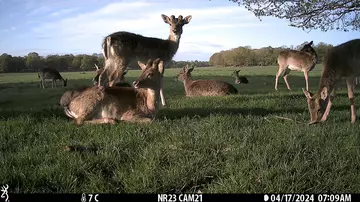
Camera traps provide a wealth of information not only for hedgehogs but for many other mammal and birds species. This makes them ideal for general biodiversity monitoring and HogWatch has been involved in projects which are aiming to learn more about the dynamics of urban biodiversity.
South London Partnership, Internet of Things
Funded by Internet of Things, in 2022 London HogWatch worked with Richmond council using cellular cameras to gather fauna data to inform their strategy of nature recovery. This data was combined with other information to advise an approach that considers site connectivity, climate change resilience and the priority actions for habitats and species. Data gathered will also be used in the future to monitor the success of planned conservation actions. HogWatch surveyed Crane Park Island for water voles prior to the planned reinforcement of the population.

Network Rail
In 2022, Network Rail and ZSL’s London HogWatch and Monitoring and Technology Team began collaborating around a comprehensive programme of research and monitoring activities designed to enhance our understanding of British lineside wildlife. The habitats around railway lines in cities may provide important sites for a wide range of plants, and insects and potentially are important corridors for a range of mammal species, including hedgehogs.
In Phase 1 of the collaboration, which was completed in March 2023, ZSL developed and trialled innovative technologies for monitoring lineside biodiversity efficiently and at a safe distance. Phase 2 commenced in April 2023 to investigate the effect of lineside habitat on British wildlife in rural and urban environments, trialling methods for small mammal monitoring on lineside environments, novel technologies for remote monitoring of dormouse nest boxes and scoping methods and technologies for landscape-scale monitoring of biodiversity across British Rail network. We deployed a total of 111 camera traps and 80 passive acoustic sensors, collecting over 200,000 images during 1,667 camera-trap days, and 3,700 hours of acoustic data. Thus far we have seen evidence of the use of these sites by a range of species including hedgehogs, badgers, and foxes. This project was nominated for Best Practice Innovation Award by CIEEM (Chartered Institute of Ecology and Environmental Management) and was highly recommended. The image below is of a vole inside one of the homemade Mostela boxes created for trialling small mammal monitoring methods.
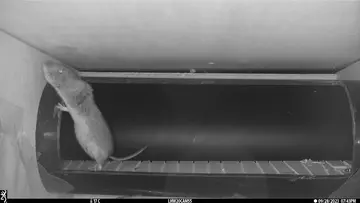
General Press
https://www.hamhigh.co.uk/news/zsl-survey-finds-hampstead-heath-a-hedgehog-hotspot-8567134
South London’s hedgehogs - PTES
Londoners urged to create ‘hedgehog highways’ to help tiny mammals roam and forage | The Independent
How to encourage hedgehogs in Kingston – Kingston Courier
Hedgehogs to get new highway in Ealing - EALING.NEWS - The Voice of Ealing 7 towns - Acton, Ealing, Greenford, Hanwell, Northolt, Perivale, Southall.
Hedgehog Crossing
England introduces first official hedgehog crossing signs - BBC Newsround
First official hedgehog crossings implemented to curb decline in species (telegraph.co.uk)
NHMP Coverage
AI to track hedgehog populations in pioneering UK project | Animals | The Guardian…..300+ more newspapers, radio, TV coverage
Pine Marten Discovery
Pine marten spotted in London for first time in more than a century | Endangered species | The Guardian
Pine marten seen in London for the first time in more than 100 years | New Scientist
https://www.sciencefocus.com/news/endangered-pine-marten-spotted-in-london-for-the-first-time-in-100-years
BBC Wild Isles TV Show
https://www.thenationalnews.com/world/uk-news/2023/03/13/sir-david-attenborough-says-nature-is-in-crisis-and-calls-for-action/
Network Rail Collaboration
https://www.networkrailmediacentre.co.uk/news/smile-for-the-camera-railways-cutest-neighbours-caught-on-film-thanks-to-network-rail-zsl-and-google-cloud-partnership
https://www.youtube.com/watch?v=eSd9GD5UwuM
British Library - the project and our project manager Kate Scott-Gatty was featured in Art, Science and Sound exhibition
https://blogs.bl.uk/sound-and-vision/2023/05/animals-art-science-and-sound.html
https://www.theguardian.com/artanddesign/2023/apr/20/animals-review-british-library-london
London HogWatch is core funded by the British Hedgehog Preservation Society (BHPS).
Over the years we've had many partners and funders some of these include:
The Royal Parks
People's Trust for Endangered Species (PTES)
Heath Hands
City of London Corporation Hampstead Heath
Friends of Richmond Park
Kingston Council
WildChiswick
Ealing Wildlife Group
Friends of Barnes Common
The Heath and Hampstead Society
London Wildlife Trust
Natural England
Network Rail
Durham University, Imperial College of London , NTU, UCL, QMUL
Mammalweb
UK Research and Innovation (UKRI) Research England
GiGL - Greenspace Information for Greater London CIC
The South London Partnership
InnOvaTe Project - Internet of Things
ZSL has been building connections between people and wildlife for almost 200 years. Today, as human activities push our planet to its limits, that’s more vital than ever – join us on the journey of recovery.
